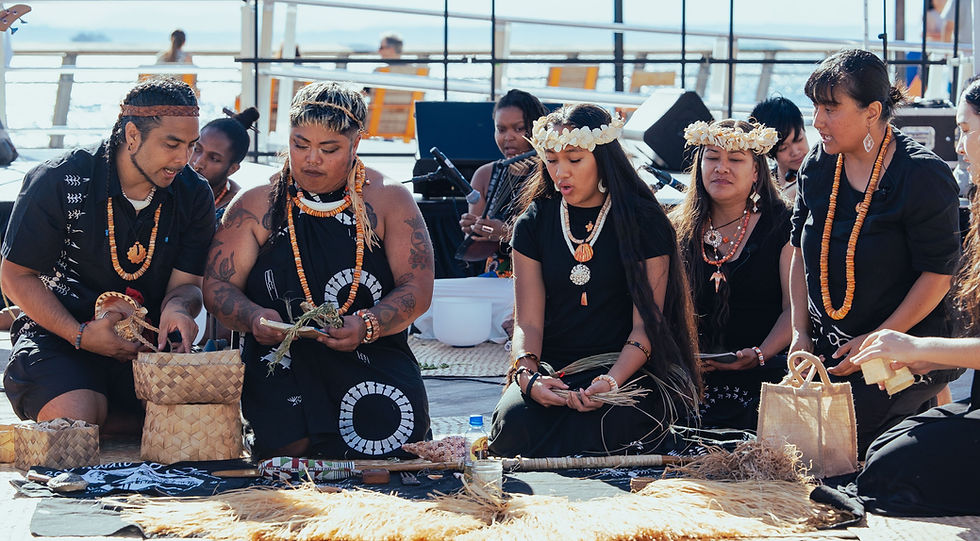Inetnon Lalåhi explores masculinity through CHamoru art
- Admin

- Jul 22
- 3 min read

By Ron Rocky Coloma
Jerrold Castro remembers the quiet. In one of the most personal pieces in Inetnon Lalåhi, the artist and curator placed a solitary figure — a talyeru — facing the water, back turned to the viewer. It is, as he describes, an homage to his late grandfather. But more than that, it is a moment of stillness, of contemplation. A kind of silence that says more than words ever could.
“There is a role of silence and vulnerability that I see in some of these works,” Castro said. “The silence grabs you because the context about this piece is really me as the artist reflecting on all the things my grandfather taught me.”
Inetnon Lalåhi, which means “A Gathering of Men,” is Guam’s first all-male art exhibition. Now open at the Guam Museum’s Café Gallery, the show features a diverse roster of local artists exploring masculinity, identity and culture through painting, sculpture and mixed media. It runs through Aug. 12.
The idea, Castro said, began with a simple question: what would a companion to the museum’s annual Famalao’an exhibit look like?
“I wanted to create an exhibit that honors the legacy of men and their role in our local culture, while acknowledging the roots of our CHamoru heritage on this island,” he said.
There is no strict theme in Inetnon Lalåhi, no prescriptive direction. Castro gave artists full creative control, asking only that they bring their best work. The results, he said, speak to CHamoru values and the island’s evolving identity.
“This show really exemplifies not just the role of CHamoru men, but how all ethnicities integrate into our local culture,” he said. “It celebrates CHamoru identity through that successful integration, which is founded in the very important CHamoru values of Inafa’maolek yan Inagofli’e.”
ADVERTISEMENT
Some of the artists were invited through long-standing friendships. Others were newcomers, found through daily encounters outside of the art world.
“I met one artist who, by chance through daily interactions that have nothing to do with art or the local art community, just happened to mention that he creates art,” Castro said. “Including him in this show is a reciprocal approach to what I experienced at the beginning of my journey — which is very much the CHamoru way.”
For Castro, masculinity isn’t a single trait or aesthetic. It is layered and sometimes contradictory. But at its core is a need that feels familiar.
“We are men moving through this world, navigating every step, negotiating every engagement and making our mark,” he said. “What I’ve found is that we are all moving through life looking for the same thing, which is to be accepted at our most authentic level.”
ADVERTISEMENT
The show balances reverence for tradition with emotional risk. Some works are bold. Others are quiet. What connects them, Castro said, is the desire to reflect something true.
“The CHamoru culture and the culture of Guam has always been a culture that is creative and honest about how they see the world,” he said. “What you will see in this show is that it was easy to balance that narrative because of the artists’ diversity, their experiences and their willingness to create work that truly reflects the world we live in.”
More than understanding, Castro hopes the exhibit evokes feeling — connection, recognition, camaraderie.
“These shared experiences are rooted in our common humanity,” he said. “They give us a sense of camaraderie and connection not just to CHamoru culture but this beautiful island culture that we developed in a very natural way.”
While Inetnon Lalåhi isn’t about gender parity, Castro sees it as a natural continuation of the island’s creative story.
“What better way to honor those shows, but to have a men’s exhibition that elevates our women and truly encapsulate our culture, our masculine nature, our cultural heritage and the idea of men coming together to uplift those around us,” he said.
As for how the show shaped his own views, Castro said it didn’t change them — it affirmed them.
“My understanding of male identity is shaped by my culture and upbringing,” he said. “We uplift those around us, we strengthen each other through our works and dialogue and we shape our understanding of the world around us through mutual respect and reciprocation.”
In the corner of the gallery, the lone talyeru still stands. Silent, grounded. A figure framed in memory — and in meaning.
Subscribe to
our digital
monthly edition













